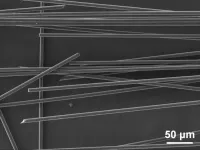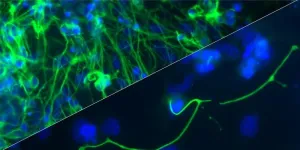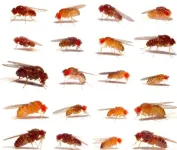(Press-News.org)
Epoxy resins are coatings and adhesives used in a broad range of familiar applications, such as construction, engineering and manufacturing. However, they often present a challenge to recycle or dispose of responsibly. For the first time, a team of researchers, including those from the University of Tokyo, developed a method to efficiently reclaim materials from a range of epoxy products for reuse by using a novel solid catalyst.
There’s a high chance you are surrounded by epoxy compounds as you read this. They are used in electronic devices due to their insulating properties; clothing such as shoes due to their binding properties and physical robustness; building construction for the same reason; and even in aircraft bodies and wind turbine blades for their ability to contain strong materials such as carbon fibers or glass fibers. It’s hard to overstate the importance of epoxy products in the modern world. But for all their uses, they inevitably have a downside: Epoxy compounds are essentially plastics and prove difficult to deal with after their use or at the end of the life of an epoxy-containing product.
“For example, to decompose fiber-reinforced plastics, perhaps used in aircraft parts, you’d need high temperatures over 500 degrees Celsius, or strong acid or base conditions. These things have an energy cost, and the harsh conditions can damage the fibers and things you might be trying to recover,” said Associate Professor Xiongjie Jin at the University of Tokyo. “To deal with this problem, a relatively new process called catalytic hydrogenolysis shows promise, but existing catalysts for this are not reusable as they dissolve in the solvent in which the epoxy decomposition takes place. So, we created a new solid catalyst which is easily recoverable and reusable.”
Jin and Professor Kyoko Nozaki, both from the Department of Chemistry and Biotechnology, and their team developed an efficient and robust catalyst to decompose epoxy compounds into carbon fibers, glass fibers and phenolic compounds, which are important raw materials in the chemical industry. The catalyst is referred to as bimetallic as it uses two metals, nickel and palladium, which are supported on cerium oxide and work together to mediate reactions between epoxy resins and hydrogen gas. Though the reaction temperature needs to be at around 180 degrees Celsius, the energy requirements are far lower than those needed to create 500-degree conditions, and the lower temperatures mean recovered materials can be reused.
“We were pleased to see experimental results that closely matched our expectations about how this process would work, but we were nicely surprised when we realized the catalyst could be reused at least five times without any reduction in its performance,” said Jin. “As our catalyst is effective at cleaving carbon-oxygen bonds, with modification, it might even work with other plastics as well, as they contain those bonds too.”
The team is now keen to explore ways to improve its methods and materials, though, as it may still take some development to make it a more commercially viable option.
“Although our catalyst does not require such high temperatures, there is still room for improvement in the environmental impact of the solvent we are currently using,” said Nozaki. “We would also like to bring the cost down by finding a catalyst that does not contain a precious metal such as palladium. It might also be possible to increase the range of materials which could be recovered from various epoxy compounds, reducing the environmental overheads of these incredibly versatile and useful plastics.”
###
Journal article: Yanze Huang, Yukari Yamazaki, Katsutoshi Nomoto, Hiroki Miura, Tetsuya Shishido, Xiongjie Jin, Kyoko Nozaki, “Bimetallic synergy in supported Ni−Pd catalyst for selective hydrogenolysis of C−O bonds in epoxy resins”, Nature Communications, DOI:10.1038/s41467-025-56488-4.
Funding and acknowledgments:
This study was supported by JST ERATO No. JPMJER2103, JSPS KAKENHI JP24K01253, JP23H04905.
Useful links:
Department of Chemistry and Biotechnology - https://www.chembio.t.u-tokyo.ac.jp/e/
Graduate School of Engineering https://www.t.u-tokyo.ac.jp/en/soe
Research contacts:
Associate Professor Xiongjie Jin
Department of Chemistry and Biotechnology, The University of Tokyo,
7-3-1 Hongo, Bunkyo-ku, Tokyo, 113-8656, Japan
t-jin@g.ecc.u-tokyo.ac.jp
Professor Kyoko Nozaki
Department of Chemistry and Biotechnology, The University of Tokyo,
7-3-1 Hongo, Bunkyo-ku, Tokyo, 113-8656, Japan
nozaki@chembio.t.u-tokyo.ac.jp
Press contact:
Mr. Rohan Mehra
Public Relations Group, The University of Tokyo,
7-3-1 Hongo, Bunkyo-ku, Tokyo, 113-8654, Japan
press-releases.adm@gs.mail.u-tokyo.ac.jp
About The University of Tokyo:
The University of Tokyo is Japan's leading university and one of the world's top research universities. The vast research output of some 6,000 researchers is published in the world's top journals across the arts and sciences. Our vibrant student body of around 15,000 undergraduate and 15,000 graduate students includes over 4,000 international students. Find out more at www.u-tokyo.ac.jp/en/ or follow us on X (formerly Twitter) at @UTokyo_News_en.
END
Searching for life in alien oceans may be more difficult than scientists previously thought, even when we can sample these extraterrestrial waters directly.
A new study focusing on Enceladus, a moon of Saturn that sprays its ocean water into space through cracks in its icy surface, shows that the physics of alien oceans could prevent evidence of deep-sea life from reaching places where we can detect it.
Published today (Thursday, 6 February 2025) in Communications Earth and Environment, the study shows how Enceladus's ocean forms distinct layers that dramatically slow the movement of material ...
A recent Brazilian study published in Nature Cardiovascular Research has highlighted promising pathways for preventing and treating atrial fibrillation, a condition that significantly raises the risks of stroke and dementia. The research was led by the Federal University of Rio de Janeiro (UFRJ) in partnership with the D’Or Institute for Research and Education (IDOR).
What Is Atrial Fibrillation?
Atrial fibrillation (AF) is the most common cardiac arrhythmia worldwide. It disrupts the normal rhythm of the heart, causing irregular and often rapid heartbeats. This condition is associated with increased risks of stroke, dementia, and heart failure. It is also linked to other health ...
How would you summarize your study for a lay audience?
Heart failure remains a substantial burden for patients due to its high prevalence and limited therapeutic options. Heart failure is classified into two major clinical subtypes— heart failure with preserved ejection fraction (HFpEF) and heart failure with reduced ejection fraction (HFrEF). While there have been significant therapeutic advances in HFrEF, the rate of complications and death from HFrEF remains high. Additionally, most drugs that have shown benefits for patients with HFrEF have not demonstrated a comparable benefit in patients with HFpEF, highlighting a critical need for the development of targeted therapies ...
People’s ability to interpret emotions or focus on performing a task is reduced by short-term exposure to particulate matter (PM) air pollution, potentially making everyday activities, such as the weekly supermarket shop, more challenging, a new study reveals.
Scientists discovered that even brief exposure to high concentrations of PM may impair a person’s ability to focus on tasks, avoid distractions, and behave in a socially acceptable manner.
Researchers exposed study participants to either high levels of air pollution - using candle smoke - or clean air, testing cognitive abilities ...
Key points:
Researchers from the Voigt lab have extended our understanding of how developmental genes are held in a poised state to allow timely expression once they receive the correct ‘go’ signals.
The next layer of regulation has been uncovered by the identification of proteins that interact with the epigenetic marks that poise developmental genes ready for expression.
The research provides insight into the mechanisms through which the phenomenon of bivalency – where both activating and repressive marks are laid down at the same site on the genome – acts to ready developmental ...
A multimillion-pound research project, called SustaPack, aims to overcome manufacturing challenges for the next generation of sustainable, paper-based packaging for liquids. Backed by a £1 million grant from the Engineering and Physical Sciences Research Council (EPSRC) as part of UKRI’s co-investing programme, packaging technology company Pulpex Ltd has joined forces with the University of Surrey to refine its manufacturing processes to provide a viable solution to plastic pollution.
Contributing matching support towards the project, Pulpex has already made significant strides in the development of its patented technology, ...
Could 2025 be the year marine protection efforts get a “glow up”? According to a team of conservation-minded researchers, including Octavio Aburto of UC San Diego’s Scripps Institution of Oceanography, the moment has arrived.
In a new study published Feb. 6 in the journal Frontiers in Marine Science, Aburto and a multinational team of marine scientists and economists unveil a comprehensive framework for Marine Prosperity Areas, or MPpAs. With a focus on prosperity—the condition ...
PISCATAWAY, NJ – Warning signs at dispensaries about the potential health effects of cannabis use in pregnancy may not be effective, according to a new report in the Journal of Studies on Alcohol and Drugs, based at Rutgers University. In fact, those who are pregnant and using cannabis may actually distrust the content of warning signs altogether.
“Mandatory warning signs aren’t working,” says lead researcher Sarah C. M. Roberts, DrPH, of the University of California, San Francisco. In fact, some of the respondents “saw the signs as having stigmatizing or negative effects on pregnant people who use ...
Finding life in outer space is one of the great endeavors of humankind. One approach is to find motile microorganisms that can move independently, an ability that is a solid hint for life. If movement is induced by a chemical and an organism moves in response, it is known as chemotaxis.
Now, researchers in Germany have developed a new and simplified method for inducing chemotactic motility in some of Earth’s smallest life forms. They published their results in Frontiers in Astronomy and Space Sciences.
“We tested three types of microbes – two bacteria and one type of archaea – and found that they all moved toward a chemical called L-serine,” ...
A study of fruit flies shows some species are highly susceptible to a wide range of viruses.
In the study – by the University of Exeter – 35 fruit fly species were exposed to 11 different viruses of diverse types.
As expected, fly species that were less affected by a certain virus also tended to respond well to related viruses.
But the findings also show “positive correlations in susceptibility” to viruses in general. In other words, fly species that were resistant to one virus were generally resistant to others – including very different ...






